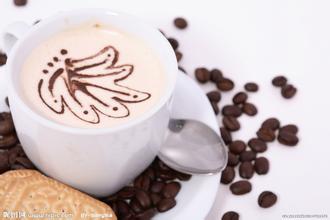A brief introduction to the History and Culture of the Origin and Development of Arabica Fine Coffee beans

Arabica? The planting conditions of coffee are harsh, requiring higher elevations (above 2000 meters above sea level), fertile soil fertility, adequate moisture, proper sunshine conditions and shade. Arabica? Coffee tree species have poor ability to resist diseases and insect pests and are easy to be damaged. In addition, the annual output of coffee trees per unit area is also lower. At the moment? Arabica? Growing coffee accounts for 75% of the world's coffee production, in these? Arabica? Of the coffee production, only 10% of the quality of Arabica coffee can be classified. Boutique coffee (Specialty coffee)? ? Robusta? Coffee is commonly known as? Thick beans can be planted at low elevations (200 to 800 meters above sea level). They are resistant to diseases and insect pests and are not vulnerable to agricultural diseases. the annual output of coffee trees per unit area is relatively high, and they are harvested in large quantities by machine. generally speaking, the production cost is much lower than that of Arabica coffee.
Arabica? Coffee has a varied and broad potential flavor. Arabica coffee produced in different regions, different elevations and different climates usually has its own characteristics and can show a completely different flavor. ? Arabica? When coffee is not roasted, it smells like grass. After proper roasting, it shows. Fruity? (medium and shallow baking) and? Caramel sweet? (deep baking), generally speaking, has a better aroma and flavor than Robota beans. ? Robusta? Coffee is usually mediocre, dull, and pungent, and because the vast majority of robusta coffee in the world is grown in low altitude areas (India has planted a small number of high-altitude, high-quality, washed robusta coffee beans, its price is higher than most Arabica coffee beans) different regions and different climates do not produce great differences in flavor, and lack personality. When unbaked, it smells like raw peanuts, and cheap robusta coffee beans usually smell like peanuts when roasted. Mai Tsai tea? (medium baking) and? Rubber tire smell? (deep baking), it is difficult to show meticulous flavor
Arabica is deeply loved by Chinese people with a short history of coffee contact because of its strong fruity aroma. it was introduced to China by missionaries in the 19th century and widely planted in Panzhihua, Sichuan, and the dry-hot valley of the Jinsha River above 1000 meters in western Yunnan. The sunshine in this area lasts for a long time and there is a great temperature difference between day and night. The local people solve the problem of insufficient seasonal rainfall by diverting water up the mountain, resulting in a unique aroma of "Chinese coffee". Among them, Banpo coffee grown in Arabica in Panzhihua, Sichuan is the most. Compared with Yunnan and Hainan, Panzhihua in the dry-hot valley has longer sunshine, higher altitude, greater temperature difference, good light quality and more virgin land. it is a rare and most suitable area for growing Arabica coffee. Banpo coffee farmers take advantage of this advantage to adopt unique planting and processing technology: first, "do not land on the ground": from collecting coffee beans to processing into finished products, coffee has been kept free from soil and other sundries to ensure its taste and quality; second, "graded collection": since coffee beans are not uniform and mature, coffee beans of the same level are collected centrally rather than mixed together. Such as manual operation, the use of a large number of labor force to collect, classify and process. The coffee here is rich in aroma, sour and bitter, and fruity, very popular with consumers and favored by foreign coffee beverage giants. Bourbon species were introduced to America from Island of Bourbon (today's French island of Reunion Island of Reunion, located in the Indian Ocean east of Madagascar) by French immigrants in the 18th century, and are now widely cultivated in Brazil and other Western Hemisphere producing areas, as well as a small amount in Yunnan, China. The caffeine content of Bobang subspecies is 20% higher than that of Tibica subspecies, but less than that of most coffee subspecies. At first, the main branch and the trunk grew upward at 45 degrees, and drooped with the fruit load. The lateral branches and nodes are dense and knot.
There are many fruits and high yield, but the berries are smaller and mature faster, so they are not resistant to strong wind and heavy rain. Bourbon coffee is a variety of small-grain coffee second only to Tibica, with more fruit, higher yield, but smaller berries and slower ripening. The small-grain coffee grown in Yunnan, China is mainly Tibika and Bobang subspecies. From the botanical point of view of coffee, Yunnan small-grain coffee is genetically similar to the recognized best blue mountains in Jamaica (Jamaica Blue Mountain) and Kona in Hawaii.
Arabica (Arabica) and? Robusta is two different coffee varieties, which currently account for the vast majority of coffee bean production in the world. Arabica seed? Coffee and? Robusta? There are three main differences in coffee: 1. Differences in planting conditions. 2. The flavor and characteristics are different. 3. The difference between market price and use. Planting condition difference
Arabica? The planting conditions of coffee are harsh, requiring higher elevations (above 2000 meters above sea level), fertile soil fertility, adequate moisture, proper sunshine conditions and shade. Arabica? Coffee tree species have poor ability to resist diseases and insect pests and are easy to be damaged. In addition, the annual output of coffee trees per unit area is also lower. At the moment? Arabica? Growing coffee accounts for 75% of the world's coffee production, in these? Arabica? Of the coffee production, only 10% of the quality of Arabica coffee can be classified. Boutique coffee (Specialty coffee)? ? Robusta? Coffee is commonly known as? Thick beans can be planted at low elevations (200 to 800 meters above sea level). They are resistant to diseases and insect pests and are not vulnerable to agricultural diseases. the annual output of coffee trees per unit area is relatively high, and they are harvested in large quantities by machine. generally speaking, the production cost is much lower than that of Arabica coffee.
Good Arabica? Coffee requires complicated manual picking, selection and meticulous processing, so are the most expensive and best coffee beans in the world? Arabica? Grow coffee. Robusta? Because of its low cost, growing coffee is usually used to produce instant coffee and canned coffee. A few of the better ones? Robusta? Grown coffee is also used in blending (mixed with Arabica coffee) espresso beans.
There is an important difference in other differences: the amount of caffeine. Robusta? The caffeine content of coffee is about? Arabica? Twice as much coffee, which is why drinking some canned coffee is prone to palpitations and insomnia.
Have you seen so much? Arabica coffee? With? Robusta coffee? Finally, it must be emphasized that:
Arabica coffee? It's not the same? Good coffee? Robusta? It's not absolutely cheap coffee!
Arabica coffee accounts for 75% of the world's coffee production, with a wide gap in quality, good and bad. In recent years, a few countries (such as India) have devoted themselves to improving the quality of robusta coffee. They have planted robusta in high altitude areas, given the most careful care, and carefully washed the coffee. As a result, they have got very high-quality robusta coffee beans! Top Robusta beans are not cheap either, getting rid of the old impression that Robusta are cheap beans! So the quality of coffee beans is no longer good or bad. Is it Arabica beans? To judge by this crude and outdated ancient standard of judgment.
Important Notice :
前街咖啡 FrontStreet Coffee has moved to new addredd:
FrontStreet Coffee Address: 315,Donghua East Road,GuangZhou
Tel:020 38364473
- Prev

A brief introduction to the treatment method of grinding degree and baking degree of Mexican boutique coffee beans
After the workers picked the coffee beans, they spread the coffee beans in a special house with ventilation on all sides. About a week later, the coffee beans were packed in loosely packed bags so that the wind could blow through the bags. After about seven weeks, the coffee beans changed color and taste. Finally, these coffee beans are selected manually, and the coffee beans of high quality are selected and officially bagged for preservation. Aldumara coffee beans
- Next

A brief introduction to the flavor, taste and aroma characteristics of high quality Angolan boutique coffee beans
Angolan Agriculture Minister Afonso Pedro Kanga revealed that Angolan coffee production this year is expected to double that of last year to 12000 tons. In 2008, in order to regain its status as a major coffee producer in the world, the Angolan government introduced a plan to receive a preferential micro-loan of US $5000 per farmer to grow coffee. Angola used to be one of the largest coffee producers in the world, producing coffee in 1974
Related
- Detailed explanation of Jadeite planting Land in Panamanian Jadeite Manor introduction to the grading system of Jadeite competitive bidding, Red bid, Green bid and Rose Summer
- Story of Coffee planting in Brenka region of Costa Rica Stonehenge Manor anaerobic heavy honey treatment of flavor mouth
- What's on the barrel of Blue Mountain Coffee beans?
- Can American coffee also pull flowers? How to use hot American style to pull out a good-looking pattern?
- Can you make a cold extract with coffee beans? What is the right proportion for cold-extracted coffee formula?
- Indonesian PWN Gold Mandrine Coffee Origin Features Flavor How to Chong? Mandolin coffee is American.
- A brief introduction to the flavor characteristics of Brazilian yellow bourbon coffee beans
- What is the effect of different water quality on the flavor of cold-extracted coffee? What kind of water is best for brewing coffee?
- Why do you think of Rose Summer whenever you mention Panamanian coffee?
- Introduction to the characteristics of authentic blue mountain coffee bean producing areas? What is the CIB Coffee Authority in Jamaica?

